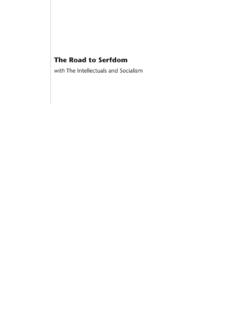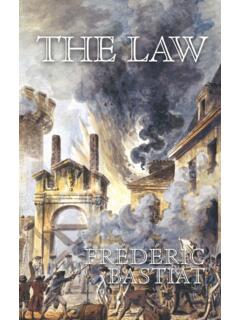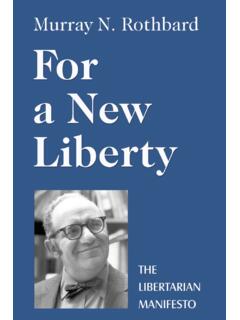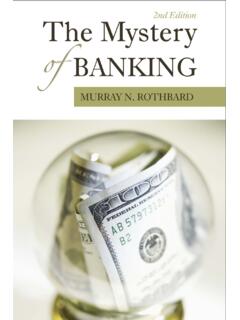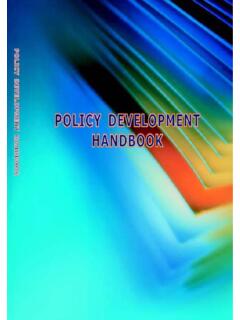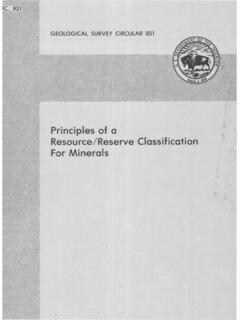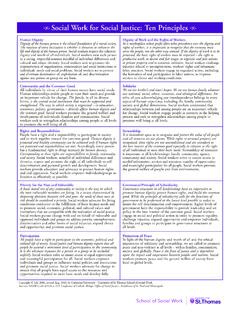Transcription of Principles of Economics - Mises Institute
1 Principles OFECONOMICSFOREWORD BYPETERG. KLEININTRODUCTION BYF. A . HAYEKTRANSLATED BYJAMESDINGWALL ANDBERTF. HOSELITZL udwigvon MisesInstituteAUBURN, ALABAMACarl MengerCover: Carl Menger portrait is courtesy of The Warren J. Samuels PortraitCollection at Duke University. Foreword Copyright 2007 by the Ludwig von Mises InstituteReprinted in 2007 by the Ludwig von Mises InstituteLudwig von Mises Institute518 West Magnolia AvenueAuburn, Ala. 36832 : 978-1-61016-202-93 CONTENTSFOREWORD BY PETER G. KLEIN .. 7 INTRODUCTION BY HAYEK .. 11 TRANSLATOR S PREFACE .. 37 AUTHOR S PREFACE.. 45I. THE GENERAL THEORY OF THE GOOD.. 511. The Nature of Goods .. 512. The Causal Connections between Goods .. 553. The Laws Governing Goods-Character .. 58A. The Goods-Character of Goods of HigherOrder is Dependent on Command ofCorresponding Complementary Goods .. 58B. The Goods-Character of Goods of HigherOrder is Derived from that of theCorresponding Goods of Lower Order.
2 634. Time and Error .. 675. The Causes of Progress in Human Welfare .. 716. Property.. 74II. economy AND ECONOMIC GOODS .. 771. Human Requirements .. 80A. Requirements for Goods of First Order(Consumption Goods) .. 80B. Requirements for Goods of Higher Order(Means of Production) .. 84C. The Time Limits within Which Human Needs are Felt .. 872. The Available Quantities.. 893. The Origin of Human economy and Economic Goods .. 94A. Economic Goods .. 94B. Non-Economic Goods .. 98C. The Relationship between Economic andNon-Economic Goods .. 101D. The Laws Governing the EconomicCharacter of Goods .. 1064. Wealth .. 109 III. THE THEORY OF VALUE .. 1141. The Nature and Origin of Value .. 1142. The Original Measure of Value .. 121A. Differences in the Magnitude of Importanceof Different Satisfactions (Subjective Factor) .. 122B. The Dependence of Separate Satisfactionson Particular Goods (Objective Factor) .. 128C. The Influence of Differences in the Qualityof Goods on Their Value.
3 141D. The Subjective Character of the Measureof Value. Labor and Value. Error .. 1453. The Laws Governing the Value of Goods of Higher Order .. 149A. The Principle Determining the Value ofGoods of Higher Order .. 149B. The Productivity of Capital .. 152C. The Value of Complementary Quantitiesof Goods of Higher Order .. 157D. The Value of Individual Goods of Higher Order .. 162E. The Value of the Services of Land, Capital,and Labor in Particular.. 165IV. THE THEORY OF EXCHANGE .. 1751. The Foundations of Economic Exchange.. 1752. The Limits of Economic Exchange .. 181 V. THE THEORY OF PRICE .. 1911. Price Formation in an Isolated Exchange.. 1942. Price Formation under Monopoly .. 197A. Price Formation and the Distribution of Goods WhenThere is Competition Between Several Personsfor a Single Indivisible Monopolized Good.. 199B. Price Formation and the Distribution of GoodsWhen There is Competition for Several Unitsof a Monopolized Good .. 203C. The Influence of the Price Fixed by a Monopoliston the Quantity of a Monopolized Good that Canbe Sold and on the Distribution of the Good Among the Competitors For It.
4 207D. The Principles of Monopoly Trading (The Policyof a Monopolist) .. 2113. Price Formation and the Distribution of Goodsunder Bilateral Competition .. 216A. The Origin of Competition.. 216B. The Effect of the Quantities of a CommoditySupplied by Competitors on Price Formation;4 Principles OF ECONOMICSthe Effect of Given Prices Set by Them on Sales;and in Both Cases the Effect on the Distributionof the Commodity Among the Competing Buyers .. 218C. The Effect of Competition in the Supply of aGood on the Quantity Sold and on the Priceat which it is Offered (the Policiesof Competitors) .. 220VI. USE VALUE AND EXCHANGE VALUE .. 226A. The Nature of Use Value and Exchange Value .. 226B. The Relationship Between the Use Valueand the Exchange Value of Goods .. 228C. Changes in the Economic Center of Gravityof the Value of Goods .. 231 VII. THE THEORY OF THE COMMODITY .. 2361. The Concept of the Commodity in its Popularand Scientific Meanings .. 2362. The Marketability of Commodities.
5 241A. The Outer Limits of the Marketabilityof Commodities .. 241B. The Different Degrees of Marketabilityof Commodities .. 248C. The Facility with which Commodities Circulate.. 254 VIII. THE THEORY OF MONEY .. 2571. The Nature and Origin of Money .. 2572. The Kinds of Money Appropriate to Particular Peoplesand to Particular Historical Periods .. 2623. Money as a Measure of Price and as the Most Economic Form for Storing Exchangeable Wealth.. 2724. Coinage .. 280 APPENDICES .. 286A. Goods and Relationships .. 286B. Wealth.. 288C. The Nature of Value .. 292D. The Measure of Value .. 295E. The Concept of Capital .. 303F. Equivalence in Exchange.. 305G. Use Value and Exchange Value .. 306H. The Commodity Concept.. 308I. Designations for Money.. 312J. History of Theories of the Origin of Money .. 315 INDEX.. 321 CONTENTS5 Ludwig von Mises , Human Action: A Treatise on Economics , Scholar s Edition (Auburn,Ala.: Mises Institute , 1998), p.
6 Volume, p. There never lived at the same time, wrote Ludwig von Mises , more thana score of men whose work contributed anything essential to Economics . 1 One of those men was Carl Menger (1840 1921), professor of politicaleconomy at the University of Vienna and founder of the Austrian School ofeconomics. Menger s pathbreaking Grunds tze der Volkswirtschaftslehre( Principles of Economics ), published in 1871, not only introduced the con-cept of marginal analysis, it presented a radically new approach to economicanalysis, an approach that still forms the core of the Austrian theory of valueand price. Unlike his contemporaries William Stanley Jevons and L on Walras, whoindependently developed their own concepts of marginal utility during the1870s, Menger favored an approach that was deductive, teleological, and, in aprimary sense, humanistic. While Menger shared his contemporaries prefer-ence for abstract reasoning, he was primarily interested in explaining the real-world actions of real people, not in creating artificial, stylized representationsof reality.
7 Economics , for Menger, is the study of purposeful human choice,the relationship between means and ends. All things are subject to the law ofcause and effect, he begins his treatise. This great principle knows no excep-tion. 2 Jevons and Walras rejected cause and effect in favor of simultaneousdetermination, the technique of modeling complex relations as systems ofsimultaneous equations in which no variable causes another. Theirs hasbecome the standard approach in contemporary Economics , accepted by nearlyall economists but the followers of Carl Menger. Menger sought to explain prices as the outcome of the purposeful, volun-tary interactions of buyers and sellers, each guided by their own subjectiveevaluations of the usefulness of various goods and services (what we now callmarginal utility, a term later coined by Friedrich von Wieser). Trade is thus theresult of people s deliberate attempts to improve their well-being, not an BY PETER G.
8 Smith, An Inquiry into the Nature and Causes of the Wealth of Nations[1776], , Skinner, and Todd, eds. (Indianapolis: LibertyClassics, 1981), book 1,p. OF Economics propensity to truck, barter, and exchange, as suggested by Adam quantities of goods exchanged their prices, in other words are deter-mined by the values individuals attach to marginal units of these goods. With asingle buyer and seller, goods are exchanged as long as participants can agreeon an exchange ratio that leaves each better off than he was before. In a mar-ket with many buyers and sellers, the price reflects the valuations of the buyerleast willing to buy and the seller least willing to sell, what B hm-Bawerkwould call the marginal pairs. Regardless of the exact structure of the mar-ket, then, voluntary exchange takes place until the gains from trade are momen-tarily exhausted. Menger s highly general explanation of price formation con-tinues to form the core of Austrian microeconomics. Menger s approach has been labeled causal-realistic, partly to empha-size its differences with the mainstream, neoclassical approach.
9 Besides itsfocus on causal relations, Menger s analysis is realistic in the sense that hesought not to develop formal models of hypothetical economic relationships,but to explain the actual prices paid every day in real markets. The classicaleconomists had explained that prices are the result of supply and demand, butthey lacked a satisfactory theory of valuation to explain buyers willingnessto pay for goods and services. Rejecting value subjectivism, the classicaleconomists tended to treat demand as relatively unimportant and concen-trated on hypothetical long-run conditions, in which objective character-istics of goods most importantly, their costs of production would deter-mine their prices. The classical economists also tended to group factors ofproduction into broad categories land, labor, and capital leaving themunable to explain the prices of discrete, heterogeneous units of these realized that the actual prices paid for goods and services reflect notsome objective, intrinsic characteristics, but rather the uses to which dis-crete units of goods and services can be put, as perceived, subjectively, byindividual buyers and sellers.
10 The Principleswas written as an introductory volume in a proposed mul-tivolume work. Unfortunately, those later volumes were never did not explicitly develop the concept of opportunity cost, he did notextend his analysis to explain the prices of the factors of production, and hedid not develop a theory of monetary calculation. Those advances wouldcome later from his students and disciples Eugen von B hm-Bawerk,Friedrich von Wieser, Clark, Philip Wicksteed, Frank A. Fetter, Davenport, Ludwig von Mises , and Hayek. Many of the most impor-tant ideas are implicit in Menger s analysis, however. For example, his dis-tinction among goods of lower and higher orders, referring to their place inthe temporal sequence of production, forms the heart of Austrian capital the-ory, one of its most distinctive and important elements. Indeed, Mengeremphasizes the passage of time throughout his analysis, an emphasis that hasnot yet made its way into mainstream economic theorizing.
